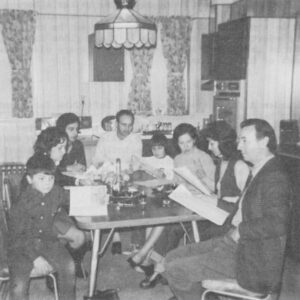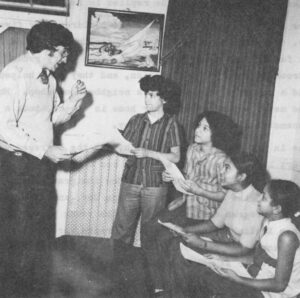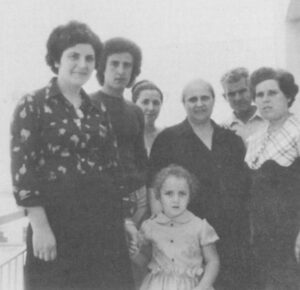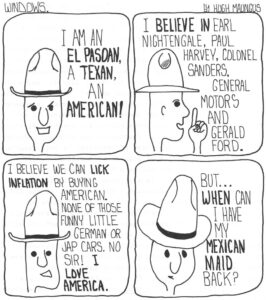BROOKLYN, N.Y. — It in a humid ninety-degree evening in August, and the vegetable vendor who works the Carroll Street subway station has decided to go home early. His cucumbers are wilted and his horse is tired. The old man and his horse-drawn vegetable cart are fixtures in a neighborhood that encompasses both the descendants of Italian immigrants who arrived in steerage at the turn of the century and now immigrants who step off planes at Kennedy Airport each week.
Around the corner in Carroll Park, old men who left Italy sore than half a century ago are playing bocce. Their grandchildren occasionally hang around and watch the old game, but most of them play baseball or basketball on a school playground across the street. Women who have been sitting in pairs on benches begin to collect their children as twilight deepens. Teenage boys and young men head for the Cafe del Sud on Court Street; it could be a cafe in any small Italian town where men meet to drink coffee, gossip and ogle girls. In this neighborhood, there are few girls to ogle after dark — not because they are afraid of being mugged or raped but because their parents do not consider it proper for young women to be out alone in the evening.
Carroll Gardens is a cohesive neighborhood, cemented by its old immigrant heritage as well as the influx of new immigrants during the past ten years. People do not worry about crime as much as they do in the more anonymous, high-rent districts of New York City; this in an area where it is difficult for muggers and burglars to operate because too many of the residents are talking and minding one another’s business on front stoops. It is a neighborhood where people offer coffee, doughnuts and shelter to friends who have been driven out of their house by a fire, where everyone pitches in to clean up the debris left by the city fire department.
The area in still known as Red Hook to anyone who grow up in South Brooklyn; it is a tougher name than “Carroll Gardens,” and it dates from an era of tough Irish and Italian street gangs. 1 It also dates from an era before people began to regard the sturdy old houses as desirable objects for real estate speculation. For several generations, Red Hook/Carroll Gardens has been a working-class neighborhood heavily populated by Irish and Italians. Italians who found work on the Brooklyn docks settled in the area after they saved enough money to escape the poorer immigrant neighborhoods on the Lower East Side of Manhattan. Many of their grandchildren have moved to the suburbs or to more expensive sections of the city, but Italian-Americans have maintained a remarkably stable presence in the neighborhood. They are now being joined by new immigrants who have been arriving in increasing numbers since the liberalization of U.S. immigration laws in 1965.
The new immigrants from Italy have one trait in common with the immigrants who arrived at the turn of the century: they try to settle near people from the same town. This tendency is reinforced by the fact that most of them find their first jobs and apartments through relatives who have been in the United States a generation or more. In Carroll Gardens, a large percentage of the new immigrants come from Mola di Bari, a town on the Adriatic. The local New York state assemblyman is 31-year-old Michael L. Peace, the son of a longshoreman who immigrated to the United States from Mola in 1955. Peace was 12 years old when his family left Mola; he may well be the only immigrant of his generation to hold an elective office in the United States. He says approximately 40 per cent of the residents in his district are Italian-American and a fifth of the ethnic Italians have arrived during the past decade. The district is about 15 per cent Puerto Rican, 15 per cent black, 15 per cent ethnic Irish and 15 per cent “others.” “I can only guess at how many new immigrants there are in this neighborhood,” he says, “because so many of them are coming in all the time. We see their problems all the time in this office, but it’s impossible to make a reasonable count because most of these people aren’t voters. The Italians are the most visible, but there are a lot of Greeks and Arabs. And a lot of people who show up in the census as “blacks” are not native Americans but new immigrants from the Caribbean. Then there are all the Spanish-speakers from various countries who get incorrectly classified as Puerto Ricans. These people really become invisible outside of their own neighborhoods once they got through customs at Kennedy.
“The big strength of the Italians after they get here, and it’s true of some other immigrants as well, in that they move into a whole network of relationships with people who come from the same place. This in important because people who have been here longer — even a few years longer — know more about how to deal with the world outside the immigrant community than the person who has just arrived.”
There in no “typical” immigrant family. Although the now immigrants share many of the same motivations, they frequently have different backgrounds — even when they come from the same towns. Some come to the United States directly from Mola, while others migrate to northern Italy in search of jobs before they make the move to America. Some leave Mola because they are poor and cannot find work that pays a living wage; the area has a high unemployment rate and has recently been hard-hit by inflation. Other immigrants belong to middle-class families. They may have had good jobs and even owned land in Mola, but they left because they were afraid their sons would not be able to find professional jobs after graduation from a university. (That fear does not apply to young women in most middle-class families; parents worry about whether the daughters will find professional son for husbands.) Mike Peace’s father, for example, owned land and a profitable fishing business when he decided to leave Mola in the 1950’s.
“I asked my father why he left,” Peace remembers, “and he always said, ‘Look at yourself and what you are doing. How can you even ask? What would there be for you to do in Mola? Passeggiare la piazza?’” (Passeggiare la piazza, which literally means “to take a walk in the piazza,” refers to a nightly promenade in the town square by young men and women in Mola. The passeggiata is sometimes used by immigrants as a half-humorous, half-denigrating metaphor for the scarcity of jobs and general lassitude of small-town life in southern Italy.)
Most new immigrant families combine a straightforward desire to make more money with a general feeling that their children will have a better chance to “move up in the world” in the United States. The latter attitude is usually accompanied by an intense interest in education — one of the main differences between today’s immigrants and the illiterate peasants who made up the bulk of migrants from Italy at the turn of the century.
A better economic life and an education for their children were linked in the minds of Natale and Rosa Maria DeCarolis when they left Mola twelve years ago on a journey that would take them first to northern Italy and then to Carroll Gardens. Natale DeCarolis in a small, wiry man who speaks with the combination of reserve and sardonic humor that characterizes many men from the Mezzogiorno. He possesses many qualities that Richard Gambino, in an outstanding study of Italian-Americans, slim up in the phrase l’uomo di pazienza. 2 The origins of this ideal of manliness, Gambino writes, go back to the Middle Ages. “It is a rich concept of what it means to be a man of which no one word is adequate. The ideal includes qualities far beyond surface maschio or masculine qualities. A man who possessed only these, only a show of manhood, was regarded as ridiculous by Southern Italians…. The familiar elements of Southern Italian manliness — non-cooperation and insubordination with regard to authorities, and distrust and aloofness from outsiders — are rooted in the much more substantial but less familiar part of the ideal. This includes a man’s cultivation and control of his own capacities and special skills — self-reliance and self-control. Hard work and self-denial are also essential components of the ideal, as are firmness of spirit, determination, and the seriousness and probity characteristic of maturity.”
Mr. DeCarolis came from an extremely poor family, but he does not talk about his childhood in Mola unless he is discussing his hopes for his own children. When he and his wife left Mola, they already had a six-year-old daughter and a seven-year-old son. Like all of the men in his family for generations, Natale DeCarolis was a fisherman. “I was away from my family all the time,” he says. “In Mola, people of my parents’ age just accepted the separation of the husband from his family as the law of life. It was the only way a man could support his wife and children. I didn’t want to live that way, but there was no other way for me to make a living in Mola.”
Rosa DeCarolis, who dreamed of going to college when she was a girl (a highly unusual and unrealizable dream for a girl growing up 40 years ago in Mola), was already concerned about the future education of the children if the family remained in the South. “I always felt I wanted more education,” she says, “but I was a girl. Parents didn’t think of this for their daughters, and they usually couldn’t afford it for their sons. But my husband and I wanted more for our children. In Italy, high school costs about $300 a year because you have to pay for the books. That doesn’t sound like much here, but it is difficult on the salaries in the south (of Italy). And college would be impossible.”
The DeCarolises left Mola for Savona, an industrial town north of Genoa. They did not consider leaving for the United States at the time, because the old system of “national quotas” was still in effect and they felt the wait would be too long. In Savona, Mr. DeCarolis quickly found work first in a factory and later with the telephone company. All of the DeCarolises enjoyed life in the North; unlike some homesick migrants, they adapted quickly to the new urban life. “I think,” says Mr. DeCarolis, “that the change between Mola and northern Italy was greater than the change between Savona and the United States. Mola is a very small town; you don’t really know how that is unless you’ve lived in one all your life. People spend a great deal of time minding each other’s business, especially when there is not enough work to go around and no one has anything else to do. I love my family, my brothers and sisters there, but I feel more of a desire to be with my own family — that is, my wife and my children. I like not having everyone else on the street know my business, and America is the same as Savona in this way.”
Rosa DeCarolis, a lively woman who speaks more rapidly than her husband, liked life in Savona for many of the same reasons. She also notes that “the woman is more free in northern Italy, more like in America. If she goes out of the house, every neighbor doesn’t have an eye on her. But the whole life in different. In Mola, the women stay at home all the time, the men go off to cafes. Life is formal — the big meal is always in the middle of the day. In Savona, the life was more like it in here. You would go off to the beach together on Sunday, or to a restaurant. The possibilities of life are broader.” The Decarolis’s younger son, Franco, was born in Savona. The two older children, Mario and Caterina, have only vague memories of Mola because they were so young when the family left. Consequently, they are not as loyal to the memory of Mola as immigrants who came directly from the South. Both Catya and Mario laughed when I asked about the quality of the high schools in Mola. “But there isn’t any high school,” Mario replied. “If you want to go to high school, you have to go to larger cities and get there as best you can.” (The situation has changed slightly since the DeCarolises left Mola. The town now operates two years of a scientific high school designed to prepare students for university entrance. Most students, however, must seek a high school education in other towns.)
The children’s education was the main reason why the DeCarolises began to consider leaving the life they liked in Savona. Mario and Catya had entered high school. Mario had shown a talent for painting and drawing, and he was interested in becoming an architect. Catya was a brilliant student, interested in everything from mathematics to literature. Both parents were determined that Mario should go to college and, unlike some Italian parents, they were pleased that Catya wanted more education. (“My parents wouldn’t have insisted that I go to a university if I didn’t want to,” Catya says, “because I an a girl. But they are happy that I do want to go, which isn’t true of some of my friends’ parents.)
Natale and Rosa DeCarolis decided they could not afford a college education for their children in Italy. They also shared a conviction expressed by many of the blue-collar workers I interviewed in Italy — that their children did not have as good a chance of getting into a university as the children of professionals and civil servants. (This belief is widely shared by all immigrants from southern Europe.)
“I have always worked,” says Mr. DeCarolis. “I hardly know how old I am; my whole life has been a search for work. My father took me out in the fishing boat when I was 11 or 12, although I didn’t have a serious steady job until I was married. Just for myself, I wouldn’t have come here. I don’t need a lot of money. What for? To put it in a bank and save it? But I know how hard work is without an education. I have much experience in life, although I don’t have much schooling, and I prefer to send my children to school so they can make money and enjoy their work later. There is no choice for a man without an education. My children all like school and do well, and this makes me very happy.
“Even if we could have afforded to send our children to a university in Italy, they wouldn’t have the same chance to be admitted because I am an ordinary worker. Here the teachers pay attention more to the intelligence of a child, not to what the father does. I am a carpenter, but that doesn’t make the teacher think my son and daughter are stupid. In Italy, the child of a worker might be more intelligent than the child of a teacher, but he wouldn’t get as good a chance. Not unless the father could afford to bribe some official, and I couldn’t.”
When the family decided to emigrate, Mrs. DeCarolis’s brother had already been in the United States for many years. (He jumped ship, as many sailors did when the quota system made it virtually impossible to enter the country legally, and was able to regularize his immigration status after he married an American citizen.) He found Mr. DeCarolis a job as a carpenter other at the New York Hilton Hotel. Many Molesi, and many other southern Italian immigrants, are carpenters. Italian immigrants gravitated to the carpenters’ union many years ago because most of the other craft unions were tightly controlled by Germans and Irish who d1covininated against the newcomers. (Italian-Americans, of course, are just as likely to discriminate against newcomers today.)
Mrs. DeCarolis’s brother also found the family its first apartment in an old building on Court Street. In 1972, the DeCarolises left Savona for Brooklyn. “I don’t think we had any exaggerated ideas of what America was like,” Mr. DeCarolis says. “We had relatives here, I had been here as a sailor. A lot of people who don’t know anything think they are going to get rich quick. You do make a better living here, but you aren’t going to become a millionaire. The one thing that is different about America is the children have more of a chance to rise in the world.”
The most pleasant surprise the DeCarolises received in the United States was the free tuition at the City University of New York. Previous generations of Italian immigrants did not send their children to college in large numbers, and most of the new immigrants are unfamiliar with the system of higher education in the areas where they settle. “I was prepared to work 20 hours a day to pay for college,” says Natale DeCarolis, “if only my children could get in. My wife was prepared to work too. Things have been much easier than we thought because there is a free university here.”
Catya and Mario are aware that their parents expect a great deal of them, but neither of them seems to find the expectations a burden. They did not speak any English when they entered public high school in 1972; both speak fluent English now. Mario, who still has more trouble with written English than his sister, in a freshman at Kingsborough Community College. After two years, he plans to transfer to a branch of the City University with an architecture school. “The classes are going to be harder for me than for an American in the beginning,” he acknowledges, “because English isn’t natural to me. I think it will take another year or so until I’m not always translating from Italian in my head.” Catya, who had two years of American high school, was able to enter Queens College — one of the beat divisions of the City University. She graduated from high school in the top 5 per cent of her class although she began her junior year with no knowledge of English. She has not decided whether to concentrate on mathematics or foreign languages in college. “I am very glad my parents left Italy,” she says firmly. “Even in Savona, many of my friends dropped out of high school because their parents needed the money they could bring in from working. There really isn’t as much opportunity there if you come from the family of a worker…. Americans don’t realize this so much, but we know. I feel I can do whatever I am capable of doing here, that I don’t have to be limited by what my parents or my grandparents do. It’s hard to talk about this with Americans. Now I’m reading books by black writers, and I am learning how different things have been for the black people in America. But still, there is more of a chance here than in other places. I feel more and more that this is so, even though I know America isn’t perfect.”
The DeCarolises would like to own a house, but keeping the children in college is the family’s first priority. Mr. DeCarolis used to make extra money by moonlighting during his paid vacations, but the serious depression in the construction industry has cut off that source of income. Like most immigrants in Carroll Gardens, he worries about the possibility of being laid off. Many immigrants arrived when the American economy was booming in the mid-Sixties and they are receiving their first taste of hard times in the United States. “No matter what happens in the next few years, I will not be sorry I came here,” Mr. DeCarolis says. “If America is having a hard time economically, in Italy it will be worse. The letters from home tell about inflation that’s four times as bad as we have it here. And the unemployment in such worse. And there isn’t a free college. If we can’t have a house now because the interest rate in high and work is slow — well, we wait. It’s not necessary to have everything you might like in life right at this minute. Americans are very impatient.”
Like many of the new immigrants in Carroll Gardens, the DeCarolises think of buying a house in another section of Brooklyn. Many Molesi live in Bensonhurst and Bay Ridge, where there in more space and single-family housing. Ironically, many immigrants move out of Carroll Gardens while upper middle-class New Yorkers pay inflated prices for brownstones in the area. Mike Pesce tries to persuade immigrants, as well as third- and fourth-generation Italian-Americans, to hang on to any property they own in Carroll Gardens. “A lot of immigrants think of this only as the first neighborhood where they settled in the United States. There is a tendency to think that moving to another neighborhood is the same thing as moving to a better neighborhood. Immigrants don’t realize how desirable this area looks to outsiders, because it really is a neighborhood. So far the ethnic balance hasn’t been changed too much because a steady flow of now immigrants replaces the old ones. An ‘immigrant neighborhood’ used to be looked down upon, but here you can see what a good thing it really is. It’s not just a place for the immigrant who stepped off the plane yesterday, but a neighborhood where people who want to can establish a pattern of life over several generations.”
Received in New York on October 30, 1974.
©1974 Susan Jacoby
Susan Jacoby, a freelance writer, in an Alicia Patterson fellow supported by the Rockefeller Foundation. This article may be published with credit to Ms. Jacoby, the Alicia Patterson Foundation and the Rockefeller Foundation.






